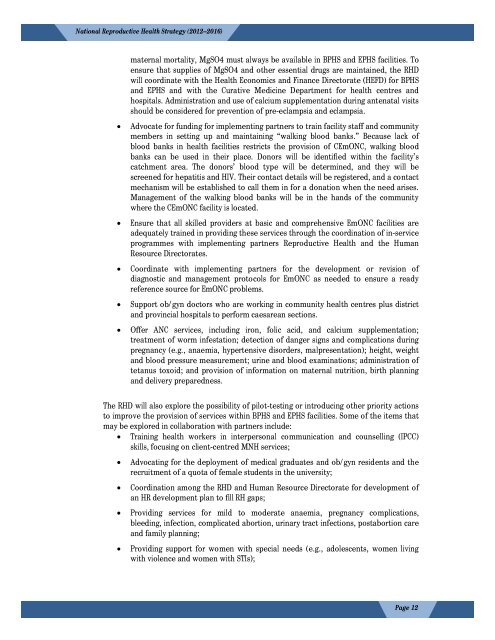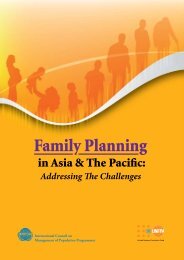national reproductive health strategy - Ministry of Public Health ...
national reproductive health strategy - Ministry of Public Health ...
national reproductive health strategy - Ministry of Public Health ...
You also want an ePaper? Increase the reach of your titles
YUMPU automatically turns print PDFs into web optimized ePapers that Google loves.
National Reproductive <strong>Health</strong> Strategy (2012–2016)maternal mortality, MgSO4 must always be available in BPHS and EPHS facilities. Toensure that supplies <strong>of</strong> MgSO4 and other essential drugs are maintained, the RHDwill coordinate with the <strong>Health</strong> Economics and Finance Directorate (HEFD) for BPHSand EPHS and with the Curative Medicine Department for <strong>health</strong> centres andhospitals. Administration and use <strong>of</strong> calcium supplementation during antenatal visitsshould be considered for prevention <strong>of</strong> pre-eclampsia and eclampsia.Advocate for funding for implementing partners to train facility staff and communitymembers in setting up and maintaining “walking blood banks.” Because lack <strong>of</strong>blood banks in <strong>health</strong> facilities restricts the provision <strong>of</strong> CEmONC, walking bloodbanks can be used in their place. Donors will be identified within the facility’scatchment area. The donors’ blood type will be determined, and they will bescreened for hepatitis and HIV. Their contact details will be registered, and a contactmechanism will be established to call them in for a donation when the need arises.Management <strong>of</strong> the walking blood banks will be in the hands <strong>of</strong> the communitywhere the CEmONC facility is located.Ensure that all skilled providers at basic and comprehensive EmONC facilities areadequately trained in providing these services through the coordination <strong>of</strong> in-serviceprogrammes with implementing partners Reproductive <strong>Health</strong> and the HumanResource Directorates.Coordinate with implementing partners for the development or revision <strong>of</strong>diagnostic and management protocols for EmONC as needed to ensure a readyreference source for EmONC problems.Support ob/gyn doctors who are working in community <strong>health</strong> centres plus districtand provincial hospitals to perform caesarean sections.Offer ANC services, including iron, folic acid, and calcium supplementation;treatment <strong>of</strong> worm infestation; detection <strong>of</strong> danger signs and complications duringpregnancy (e.g., anaemia, hypertensive disorders, malpresentation); height, weightand blood pressure measurement; urine and blood examinations; administration <strong>of</strong>tetanus toxoid; and provision <strong>of</strong> information on maternal nutrition, birth planningand delivery preparedness.The RHD will also explore the possibility <strong>of</strong> pilot-testing or introducing other priority actionsto improve the provision <strong>of</strong> services within BPHS and EPHS facilities. Some <strong>of</strong> the items thatmay be explored in collaboration with partners include: Training <strong>health</strong> workers in interpersonal communication and counselling (IPCC)skills, focusing on client-centred MNH services;Advocating for the deployment <strong>of</strong> medical graduates and ob/gyn residents and therecruitment <strong>of</strong> a quota <strong>of</strong> female students in the university;Coordination among the RHD and Human Resource Directorate for development <strong>of</strong>an HR development plan to fill RH gaps;Providing services for mild to moderate anaemia, pregnancy complications,bleeding, infection, complicated abortion, urinary tract infections, postabortion careand family planning;Providing support for women with special needs (e.g., adolescents, women livingwith violence and women with STIs);Page 12














